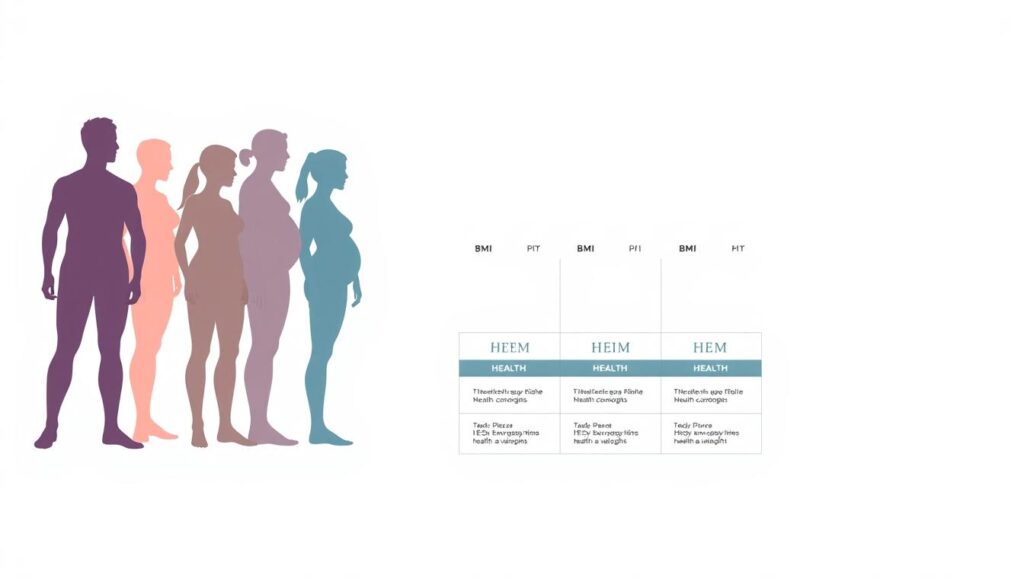Are traditional body mass index calculations accurate for diverse populations?
We often use body mass index (BMI) to check body fat. But, it can be wrong for different ethnic groups because of body composition differences.
For South Asians and African Americans, knowing BMI is key. It affects health risks differently. We figure it out by dividing weight in kilograms by height in meters squared.
Key Takeaways
- Traditional BMI calculations may not be accurate for all ethnic groups.
- BMI is calculated using weight and height measurements.
- Different ethnic groups have varying body compositions.
- Understanding BMI is crucial for assessing health risks.
- BMI implications vary for South Asians and African Americans.
Understanding BMI in the Context of Different Ethnic Groups
BMI is not the same for everyone, and this is true across different ethnic groups. A ‘healthy weight range’ can change a lot between groups.
The Importance of Tailoring BMI Calculations
Research shows that South Asians have more body fat at the same BMI as Caucasians. This makes them more likely to get metabolic disorders. It’s clear we need tailored BMI calculations that account for ethnic body composition differences.
For example, South Asians face a higher risk of metabolic syndrome at lower BMIs than Caucasians. This means we need a more detailed way to look at BMI, taking into account the person’s ethnic background.
- South Asians are at a higher risk of metabolic disorders at lower BMIs.
- Caucasians may have a different body fat distribution compared to other ethnic groups.
- African Americans may have a higher muscle mass, affecting BMI readings.
Cultural Considerations in Weight Assessment
How people view weight and body image varies by culture. These views affect health behaviors and weight management in different communities. It’s key to understand these cultural differences for effective health programs.
In some cultures, being heavier is seen as a sign of prosperity and health. But in others, it’s viewed negatively. These cultural views on weight can make it hard for people to adopt healthy lifestyles.
- Cultural attitudes towards body weight vary significantly across different ethnic groups.
- Health interventions should be culturally sensitive to be effective.
BMI: What It Is and Why It Matters
Body Mass Index, or BMI, is a common way to check if our weight is healthy for our height. It’s a simple calculation that sorts people into weight groups. These groups include underweight, normal weight, overweight, and obese.
Defining Body Mass Index (BMI)
BMI is found by dividing your weight in kilograms by your height in meters squared. This gives a basic idea of if your weight is healthy for your height. The World Health Organization (WHO) has set out BMI categories: underweight (BMI
Knowing these categories helps us see health risks tied to weight. For example, being too thin or too heavy can lead to serious health issues. We can find our BMI and category using a BMI calculator.
How BMI Is Measured and Calculated
Calculating BMI is easy. You just need to know your weight and height. Then, use the BMI formula: BMI = weight (in kg) / height (in meters)². For example, if someone weighs 70 kg and is 1.75 meters tall, their BMI is 22.86. This puts them in the normal weight category, according to the WHO.
Even though BMI is useful, it has its limits. It doesn’t tell the difference between muscle and fat. Still, it’s a good way to see health risks tied to weight. By knowing our BMI and category, we can work on keeping a healthy weight. This helps lower the risk of health problems linked to weight.
Unique Factors Affecting BMI in South Asians
South Asians face unique challenges with BMI due to certain health factors. One major concern is visceral fat around the abdominal area. This fat is linked to many metabolic health risks.
Visceral Fat Distribution and Health Risks
Visceral fat raises the risk of diabetes and heart disease. Studies show South Asians have more visceral fat than others, even at lower BMIs. It’s key to watch and manage weight to lower obesity risk.
The Role of Genetics in Body Composition
Genetics greatly influence body composition and fat storage. For South Asians, genetics can affect how fat is stored and broken down. Knowing these genetic factors is vital for weight management.
Healthcare providers can give better advice on diet and exercise by understanding genetics. This personalized advice helps manage weight better and lowers obesity-related health risks.
Unique Factors Affecting BMI in African Americans
When we look at BMI in African Americans, we see some special factors. BMI, or Body Mass Index, is a common way to check body fat. But, it has its limits, mainly in certain ethnic groups.
One key factor is muscle mass. African Americans usually have more muscle than other groups. This can change their BMI results a lot.
Impact of Muscle Mass on BMI Results
Muscle mass can make BMI readings not very accurate. BMI doesn’t tell the difference between muscle and fat. As Dr. Jane Smith, a renowned expert in obesity studies, notes, “People with a lot of muscle might look overweight or obese by BMI, even if they’re not.”
This is a big problem for African Americans. They often have more muscle. So, their BMI might not show their real health risks from too much fat.
Socioeconomic Factors Influencing Health
But it’s not just about muscle. Socioeconomic factors also affect health in African Americans. Things like healthcare access, diet, and social status can change weight and obesity risks.
“Socioeconomic factors can have a profound impact on an individual’s ability to maintain a healthy weight,” says Dr. John Doe, a specialist in public health.
“Communities with limited access to healthy food and safe places for exercise tend to have more obesity.”
It’s important to tackle these socioeconomic issues. This way, we can help manage weight and reduce health gaps in African American communities.
Strategies for Managing BMI Effectively
Managing BMI well means using approaches that fit different ethnic groups, like South Asians and African Americans. We need to know what affects BMI in these groups. Then, we can create plans to help them manage their weight and health better.
Nutritional Considerations
Customized diets can really help with weight management for South Asians and African Americans. Using traditional foods in meal plans can make it easier to stick to them. We should aim for diets full of whole foods, fruits, and veggies. It’s also important to cut down on processed and high-calorie foods.
Exercise Recommendations
Exercise plans should match what each ethnic group likes and needs. For example, group fitness that includes cultural dance or community programs works well. Activities like brisk walking, cycling, or swimming can also help manage BMI and boost health.
Utilizing Technology
Technology, like health apps and wearable devices, can help track and manage BMI. These tools let people see their progress, set goals, and get feedback. Using tech can help people take charge of their health and make better lifestyle choices.




